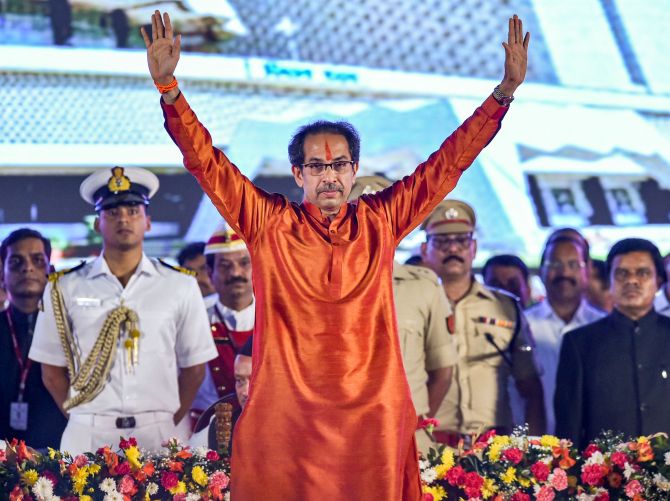 | « Back to article | Print this article |
'The Sena has lived with the BJP long enough to know its vulnerabilities and how to hit where it hurts the most,' points out Amulya Ganguli.

If Rahul Gandhi does not throw a spanner in the works, it is time that the national Opposition took the initiative to make the Shiv Sena a part of the non-BJP group outside Maharashtra as well.
Now that Sanjay Raut, executive editor of the Sena newspaper Saamna, has indicated the party's willingness to participate in all future Opposition conclaves, no time should be lost to invite the Sena to join the UPA.
Since the Sena is now 'out of the NDA', as Raut has said, and 'will be with the UPA' on all 'key' national issues, there needn't be any delay in formalising this informal togetherness.
But for a 'miscommunication', the Sena might have attended the recent Sonia Gandhi-led meeting on the citizenship law.
If this had happened, it would lessened to some extent the glee of the pro-BJP television channels over the absence of the Trinamool Congress, the BSP, the DMK and the Aam Aadmi Party from the meeting, as their decision to stay away highlighted yet again the fissures in the anti-BJP camp.
In contrast, what the Sena's presence would have accomplished is to carry forward the ruling Maharashtra Vikas Aghadi's successful experiment in forging an alliance of unlikely partners, based on a common antipathy towards the BJP, thereby falsifying the 'maha-milayat' narrative of a 'khichdi' (hodge-podge) combine which damaged the pre-general election endeavours to constitute a mahagathbandhan or a grand alliance.
Building on what the MVA has achieved so far (including victory in the Nagpur local elections) is all the more necessary to erase the distressing memories of the collapse of the Janata Dal-Secular-Congress tie-up in Karnataka which reinforced the 'maha-milayat' slur.
Unlike the Karanataka scene, the MVA's formation has been little short of a miracle, given the inherent contradictions between the Sena, the Nationalist Congress Party and the Congress.
However, the glue holding the unlikely allies together is not power so much as the BJP's looming threat to the Sena's future in the state.
The MVA will survive as long as the Sena feels fully assured that that the BJP has become weaker in the state as well as at the Centre.
It is to put up a challenge to the BJP at the Centre that the Sena can play a crucial role as a constituent of the UPA.
There are two reasons why it is in a position to do so.
One is that the Sena has a sharp tongue which will be more effective in countering the BJP's demagogues than, say, the Congress's Adhir Ranjan Chowdhury although he is trying his best and is not shooting himself in the foot as Shashi Tharoor and Mani Shankar Aiyar tend to do.
The other reason is that the Sena has lived with the BJP long enough to know its vulnerabilities and how to hit where it hurts the most.
There is little doubt that Sena will be more of an asset to the UPA than the unpredictable Mamata Banerjee and Mayawati and the uncertain Akhiesh Yadav, who is apparently more preoccupied in keeping his father and uncle at bay than in bolstering an anti-BJP front.
The other 'x' factor which can queer the pitch for a UPA-Shiv Sena bonhomie is the role of the Congress's former and possibly future president, Rahul Gandhi.
The Congress in Maharashtra was bold enough to ignore and deflect the party's First Family's reluctance to go along with the Sena on the grounds that it might alienate Muslims.
Maharashtra's Congressmen were also helped in their defiance of the family by, first, some nifty politicking by NCP supremo Sharad Pawar (including an intriguing pow-wow with Narendra Damodardas Modi), and, secondly, by the lure of entering the corridors of power.
But whether they can withstand a frontal assault by Rahul Gandhi is unclear.
The way out is for Pawar once again to take forward the agenda of thwarting the BJP by ensuring the Sena's entry into the UPA.
Amulya Ganguli is a writer on current affairs.